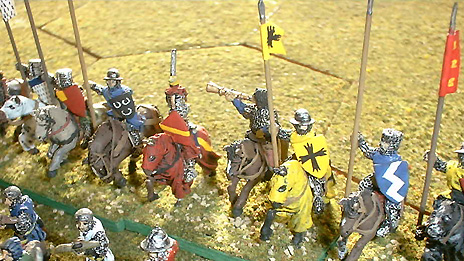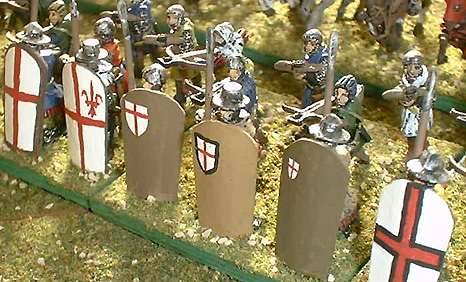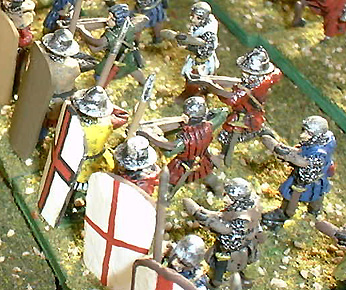
Mercenary Knights
This page last modified: 23 October, 2001

Mercenary Knights
The Communal Italian army I field is a 13th century force, ostensibly originating from Milan, but including various allies as well (though strangely enough, the current army list doesn't allow for any allies from other Italian communes). These mounted knights and other men-at-arms represent a mixed mercenary force, most being Italians, a few being German Oltramontani, with a smattering of other foreigners thrown in. The foreigner element was to become increasingly important over the years; by the early 14th century much of Italy was being overrun by unchecked German freebooters.
These figures are by Gladiator; from their feudal range. In DBM terms, they are Reg Kn (O). Kn (O) are somewhat hampered by their lack of speed, and high points cost, and are thus not considered a favoured troop type in competition-style battles. Certainly I don't use very many in my army.

Pavisari and Crossbowmen
As the 13th century progressed, the communal militia seem to have become more heavily equipped. In addition to more armour being worn, the crossbowmen that provided the best part of the army's missile power were also provided with specialist pavise bearers to further protect them. The pavises were very large, and needed to be carried by specially provided baggage animals when on the march. They were to all intents and purposes a moveable wall, and indeed in one battle a line of such pavises was actually mistaken for a stockade.
Dino Compagni, a contemporary Florentine wrote of the battle of Campaldino between Arezzo and Florence in 1289 that the Florentine "captains of the war placed the picked cavalry in front of the main body, and those armed with large shields bearing the red lily on a white ground were drawn up to support them. Then the Bishop (of Arezzo), who was shortsighted, asked, 'What walls are those?' and received the answer, 'The enemy's shields.'" See here for more of the account.
The pavise bearers and the crossbowmen aiming their weapons are by Mirliton; the crossbowmen in the rear are by Gladiator.

Pavisari and Crossbowmen
Another view of the Crossbowmen formation. In DBM terms, such a mixed formation is termed Regular Bw (X). By virtue of the front rank of spear-armed pavisiers, they are more resistant to most heavy infantry than other bowmen, and almost immune to enemy mounted troops. Due to a quirk of the rules they are somwhat more vulnerable to enemy archery than most bowmen are however.
Regular Bw (X) are usually based in two ranks with 4 pavisiers in front and 4 shooters to the rear. There are problems with this arrangement however - it means the rear ranks figures aim at the backs of the heads of those in front, rather than between them, leaves rather a lot of free space on the base, and means the spear armed troops are heavily over-represented in terms of the proprotion of shooters to pavise bearers. Kevin Donovan suggested that I should instead base them in a 3-2-3 formation. I was sceptical, since this would lead to gaps in the shield wall, but upon trying it out, I saw that this small problem was more than compensated for by the other improvements.
Return to my army list index, my figure galleries index, or my homepage index.